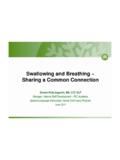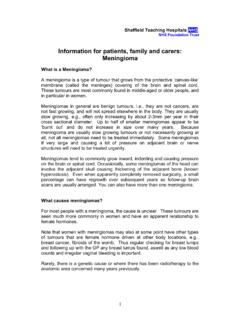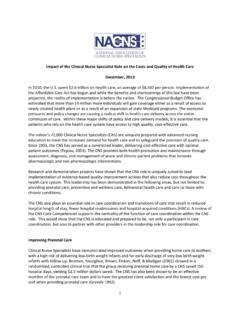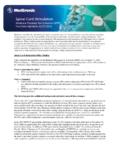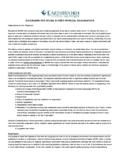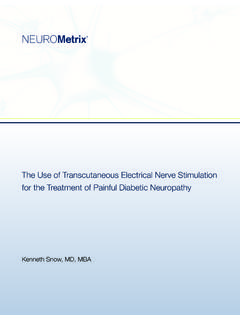Transcription of Post Anesthesia Care - North Country Health …
1 3/16/20121 post Anesthesia CAREMARCH 23, 2012 have a basic comprehension of different anesthetic approaches Understand common post Anesthesia complications and treatments Understand appropriate post Anesthesia focused assessments Understand the use of the AldreteScore Understand PACU discharge criteria Be able to answer the question: Is the patient recovered?!??!!? Tertiary care Centers Higher acuity, more resources Critical Access Hospital No designated PACU after hours Non traditional PACU settings3/16/20122 Need recognized within the last 50 years Specialized nursing care required WW II Increasingly Complex Sicker Patients ICU Inpatient vs. Outpatient Changes to procedures Open vs. Laparoscopic/Arthroscopic Ambulatory vs. inpatient Changes to anesthetics Propofol Volatile Anesthetics Regional Anesthesia3/16/20123 ENDOTRACHEALTUBE INTUBATIONLARYNGEAL MASK AIRWAYSPINAL ANESTHESIAEPIDURAL Anesthesia Peripheral Nerve Blocks Primary Anesthetics Used as the sole anesthetic Adjuncts for pain relief Used in conjunction with other anesthetics Decreases wind up 3/16/20124 Not the same as Sedation/Analgesia Deeper level of sedation Always administered by an Anesthesia provider Incremental doses Benzodiazepines Propofol Opioids Alpha AgonistsGENERAL REPORT Patient identification Age Surgical procedure Diagnosis Summary of PMH Allergies Medications Preoperative vital signs Specific features such as deafness, psychiatric issues.
2 Or language barriersPHARMACOLOGICAL REPORT Location and size of IV catheters Premedication Antibiotics Anesthetic drugs for induction and maintenance Opioids Muscle relaxants Reversal agents Vasoactivedrugs Bronchodilators Other relevant medications3/16/20125 PROCEDURAL REPORT Exact nature of the surgical procedure Relevant surgical issues Circulating RN reportANESTHETIC REPORT Emphasis on problems that may impact the immediate postoperative course: Lab values Difficult IV access Difficult intubations Intraoperative hemodynamic instability Electrocardiogram changes PACU ordersHemodynamic ComplicationsRespiratory ComplicationsRenal ComplicationsNeurological ComplicationsPOST OPERATIVE ASSESSMENTS , COMPLICATIONS and INTERVENTIONS3/16/201261. Airway Is it patent?2. Breathing Respiratory rate and rhythm, oxygen administration3.
3 Mental Status level of consciousness4. Surgical Incision Site/Dressing/Drains5. Vital Signs6. Intravenous Fluids7. Other Tubes: Foley, NG tube, suction, amount and type of drainage Level of Consciousness Breathing Pattern Peripheral Perfusion Vital signs Non invasive Invasive Appropriate intervals Q5m x first 30 minutes, q15m x4, q30m x 2, q4h Throughout all assessments you need to think globally! Airway Breathing Lung Sounds Work of Breathing SpO23/16/20127 Hypoxemia Atelectasis Hypoventilation Diffusion hypoxia Upper airway obstruction Bronchospasm Gastric aspiration Pulmonary edema Pneumothorax Pulmonary embolism Hypoventilation Decreased ventilatory drive Pulmonary and respiratory muscle insufficiency Preexisting respiratory disease Inadequate reversal of neuromuscular blockade Upper airway obstruction Inadequate analgesia Bronchospasm Pneumothorax Intubated Patients Delayed emergence from general Anesthesia Inadequate reversal of neuromuscular blockade Inadequate gas exchange Potential for airway obstruction Full stomach Hemodynamic instability Hypothermia3/16/20128 Supportive Treatments Consult Respiratory Colleagues BiPAP/CPAP Reintubation?
4 Adequate arterial PaO2 or SpO2 Adequate breathing pattern Adequate level of consciousness Recovery of muscle strength Prepare for reintubation! Heart rate Rhythm Blood pressure Rhythm strip Perfusion Capillary refill Pulses Color and temperature of nail beds and skin3/16/20129 Monitor for hemorrhage Increasedbleeding (surgical site) or other places Decreased blood pressure Increased respirations Weak, thready pulses Cool clammy, pale skin Restlessness True Hypovolemia Relative Hypovolemia Vasodilation Decreased Inotropy Hypertension Most commonly in patients with preexisting disease Multifaceted Presentation Important to verify accuracy!3/16/201210 Hypertensive treatment goal: Restore blood pressure to the preprocedurelevel Resuming of chronic antihypertensive treatment is ideal, but some fast acting treatments are: Beta Adrenergic Blockers Calcium Channel Blockers Vasodilators/Nitrates Alpha Adrenergic Blockers Arrhythmias Many different causes PAC sand Unifocal PVC s Paroxysmal Supraventricular Tachycardias Sinus Bradycardia Stable Ventricular Arrhythmias Unstable VT and VF Myocardial Ischemia and Infarction T Wave Changes Very common postoperatively ST Segment Elevation or Depression Highly specific measure for myocardial ischemia or infarction Interventions3/16/201211 Many different ways to assess patient s temperature Axillary Oral Temporal Rectal Foley Catheter Esophageal Nasal Hypothermia.
5 OR and PACU are at a lower temperature Certain patients at a higher risk Hypothermia/Shivering Hypothermia: increases the average PACU stay by 40-90 minutes Result of intraoperativehypothermia or effects of anesthetic agents Normally directly related to duration of surgery and amount of volatile anesthetic used Body s efforts to increase temperature Due to the impaired response of the body, can have adverse effects Hyperthermia Malignant Hyperthermia True Anesthesia emergency Genetic deletion Causes increased Calcium secretion out of cells Can occur anytime in the perioperativeperiod3/16/201212 Monitor lab values Sodium Potassium Chloride Glucose Hemoglobin Hematocrit Assess hydration status Assess Fluid balance Amount positive or negative Type Rationale of fluid replacement Urine output Estimated fluid loss Estimated blood loss.
6 Level of consciousness Progression of changes Pupillary reflexes Gag reflexes Hand grips Movement of extremities Orientation Person, Place, Time, Current Events Variations depending on anesthetic Regional Blocks Neuraxial Dermatones3/16/201213 Delayed awakening: Persistent effects of Anesthesia : most common Decreased cerebral perfusion Metabolic Neurological Damage Stroke Thromboembolicor hemorrhagic Emergence Delirium Peripheral Neurologic Lesions Assess, Assess, Assess Blood glucose Report to provider Radiological studies Postoperative restlessness pain manifestation Can be triggered by many other serious systemic disturbances Significant agitation may require restraints to prevent self injury Marked preopanxiety can trigger postopagitation Adverse drug effects Persistent agitation may require sedation3/16/201214 Anesthetics slow gastric motility Bowel Sounds Faint or absent immediately post -op Assess for distention Paralytic ileus From bowel handling/ Anesthesia Nasogastric/orogastrictube Assess patency, color.
7 And amount of drainage NPO until alert Ice chips then clear liquid and progress NPO for 2-3 days or greater for GI surgery Mouth care if NPO -ice chips if allowed Emesis basin within reach Anti-emetics for nausea Urinary output 30-50 ml/hr or void within 8-12 hrs Color Odor Urge to void May have bloody urine post -op for urinary tract surgery NeuraxialAnesthesia3/16/201215 Maintain foleypatency Palpate for bladder distention Bladder Scan No need to straight cath! Catheterize if needed Report your findings Oliguria: Urine output of less than ml/kg/hr Prerenal Intrarenal Postrenal Polyuria Electrolyte Disturbances Ocular injuries and visual changes Hearing impairment Oral, pharyngeal, laryngeal injuries Nerve injuries Soft tissue and joint injuries3/16/201216 PHASE I Immediate Intensive care Level During Emergence and AwakeningPHASE I PATIENTS ARE: Somnolent Hemodynamicallyunstable Require supplemental oxygen/airway adjuncts Need pain interventions Need nausea interventions Unstable surgical sitesPHASE II Lower Level of care Ensures that the patient is fit to go home FasttrackingPHASE II PATIENTS ARE.
8 Awake or easily arousable Hemodynamically stable On RA with adequate SpO2 Minimal pain Minimal nausea Stable surgical site3/16/201217 post Anesthesia Risk Score (PARS) A scoring system that identifies when clients are ready for discharge from the post Anesthesia care unit (PACU) Score must be 8 to 10 before discharge from the PACU Evaluates: activity, respiratory, circulation, consciousness, O2 saturation Adequate analgesia begins in the OR and continues in PACU. Nonopioidanalgesics Non steroidal Anti-inflammatory Drugs (NSAIDs) Cox I and Cox II inhibitors Selective Cox II Opioids: Mainstay of perioperative pain management Fentanyl Morphine Dilaudid Demerol OpioidAgonist Antagonists: rarely used Anxiolysis Benzodiazepines Regional Anesthesia Patient Controlled Analgesia3/16/201218 #1 reason why patients get admitted post op for Anesthesia Four receptors Histamine Opiate Serotonergic(5HT3) Dopaminergic Patient factors Young age Female gender, particularly if menstruating on day of surgery or in first trimester of pregnancy Large body habitus History of prior postoperative emesis History of motion sickness Postoperative factors Postoperative pain Hypotension Anesthetic techniques General Anesthesia Drugs Opioids Volatile agents Neostigmine Surgical procedures Strabismus surgery Ear surgery Laparoscopy Orchiopexy Ovum retrieval Tonsillectomy3/16/201219 Medications Propofol Ondansetron(Zofran).
9 Very effective prophylacticallyand as rescue Metoclopramide(Reglan): less effective but acceptable alternative Transderm-ScopPatch: great pretreatment Dexamethasone(Decadron): Great when combined with other treatments Droperidol: Great treatment NonpharmacologicalTreatments: Adequate hydration: 20 ml/kg Acupuncture: P6 wrist point Controversy All patients with multiple risk factors should receive treatment Two or more agents is more effective than one Outcome studies suggest little or no difference between prophylaxis and treat as needed strategies. Time of great physiological stress Recovery from inhalational based anesthetics Emergence is directly proportionate to alveolar ventilation but inversely proportionate to the agent s solubility. Hypoventilation delays awakening Laryngeal Mask Airways: Lighter anesthetic load than ETT.
10 Recovery from IV anesthetics Functions of the pharmacokinetics. Preoperative medications Uncomplicated Peripheral Nerve Blocks Neuraxial Spinal/Epidural3/16/201220 Easily arousable and oriented Hemodynamically stable Normothermic Maintain adequate ventilation Protect airway Nausea and pain control adequate Voiding Ambulating Adequate oral intake No excess bleeding or drainage Received and UNDERSTOOD written discharge instructions and prescriptions. Patient and responsible party verbalize an understanding of instructions Discharge with responsible adult3/16/201221 Signs and symptoms of infection Medications: dose, schedule, purpose Activity restrictions Hygiene Diet Wound care Follow-up appointment List of contact phone numbers in case or questions or emergency Emergency instructions Standard I: All patients who have received general Anesthesia , regional Anesthesia , or monitored Anesthesia care shall received appropriate postanesthesiamanagement.




